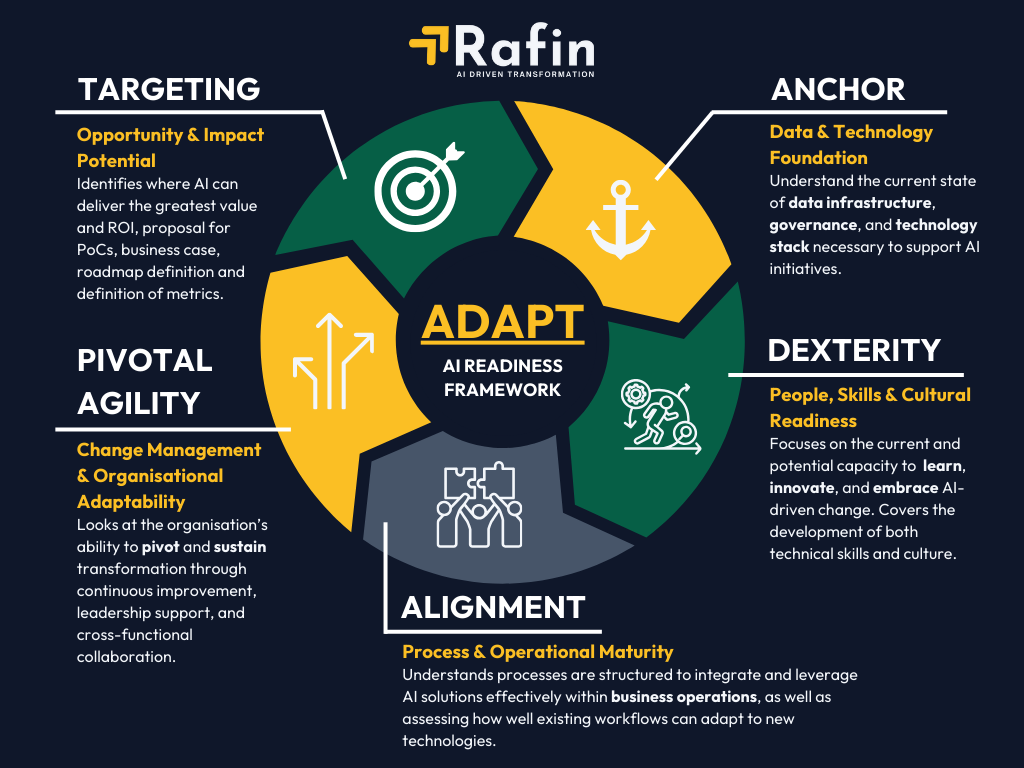Introducing the ADAPT Framework: An all compassing and flexible assessment for AI readiness.

The ADAPT Framework: Your Guide to AI Readiness
In today’s rapidly evolving business landscape, artificial intelligence (AI) isn’t just a buzzword—it’s a transformative force reshaping how organisations operate. However, successfully implementing AI isn’t just about having the latest technology. It requires a holistic approach that considers every aspect of your organisation. This is where the ADAPT Framework comes in.
What is the ADAPT Framework?

The ADAPT Framework is a comprehensive methodology designed to assess and enhance an organisation’s readiness for AI implementation. It consists of five key dimensions that together create a foundation for successful AI adoption:
Anchoring: Building Your Data and Technology Foundation
Think of Anchoring as laying the groundwork for your AI journey. Just as you wouldn’t build a house without a solid foundation, you can’t implement AI without robust data infrastructure and technology systems. This dimension ensures your organisation has:
- High-quality, accessible data
- Scalable technology infrastructure
- Strong data governance policies
- Efficient system integration
Organisations often stumble in their AI initiatives because they overlook this crucial foundation. Without clean, reliable data and the right technology stack, even the most sophisticated AI solutions will struggle to deliver value.
Dexterity: Empowering Your People
AI transformation is as much about people as it is about technology. The Dexterity dimension focuses on understanding the skills, mindset, and cultural readiness necessary for AI adoption. This includes:
- Developing AI literacy across the organisation
- Building technical capabilities in key teams
- Fostering an innovation-friendly culture
- Creating learning pathways for continuous development
Remember, the most sophisticated AI tools are only as effective as the people using them. Investing in your team’s capabilities is crucial for long-term success.
Alignment: Optimising Your Processes
AI doesn’t exist in isolation—it needs to be seamlessly integrated into your existing operations. The Alignment dimension examines how well your current processes can accommodate AI capabilities. This involves:
- Assessing process maturity
- Identifying automation opportunities
- Streamlining workflows
- Ensuring operational readiness
When AI aligns with your core processes, it becomes a natural extension of your operations rather than a bolted-on addition.
Pivotal Agility: Managing Change
Implementing AI is a journey of continuous change and adaptation. Pivotal Agility measures your organisation’s capacity to navigate this transformation successfully. Key aspects include:
- Change management capabilities
- Stakeholder engagement
- Adaptive leadership
- Cross-functional collaboration
Organisations that excel in this dimension can pivot quickly, learn from experience, and maintain momentum in their AI initiatives.
Targeting: Focusing on Impact
The final dimension ensures your AI efforts create meaningful business value. Targeting helps organisations:
- Identify high-impact opportunities
- Prioritise resources effectively
- Validate initiatives through proof of concepts
- Track and measure success
By focusing on areas with the greatest potential impact, organisations can maximise their return on AI investments and build momentum for broader transformation.
Putting the Framework into Action
The ADAPT Framework isn’t just a theoretical model—it’s a practical tool for assessing and improving your organisation’s AI readiness. Here’s how to get started:
- Assess Your Current State: Use the framework to evaluate your organisation’s strengths and weaknesses across all five dimensions.
- Identify Gaps: Determine where you need to improve to support your AI ambitions.
- Prioritise Actions: Focus on the most critical areas first, building a strong foundation for success.
- Measure Progress: Regularly assess your advancement using the framework’s dimensions as benchmarks.
Common Pitfalls to Avoid
When implementing the ADAPT Framework, watch out for these common challenges:
- Rushing to implement AI without sufficient foundational work
- Focusing too heavily on technology while neglecting people and processes
- Underestimating the importance of change management
- Trying to tackle too many initiatives simultaneously
- Failing to measure and communicate progress
Looking Ahead
As AI continues to evolve, the ability to adapt and scale AI initiatives will become increasingly crucial for business success. The ADAPT Framework provides a structured approach to building this capability, ensuring organisations can capitalise on AI opportunities while managing associated risks.
Conclusion
The journey to AI readiness isn’t about quick fixes or silver bullets. It requires a systematic approach that considers all aspects of your organisation—from data and technology to people and processes. The ADAPT Framework provides the roadmap for this journey, helping organisations build the capabilities they need to thrive in an AI-powered future.
Remember, every organisation’s path to AI maturity is unique. Use the ADAPT Framework as a guide, but tailor its application to your specific context, challenges, and objectives. With careful attention to each dimension and a commitment to continuous improvement, you can build the foundation for successful AI adoption and transformation.
Are you ready to ADAPT? Contact us here today or book a call.

